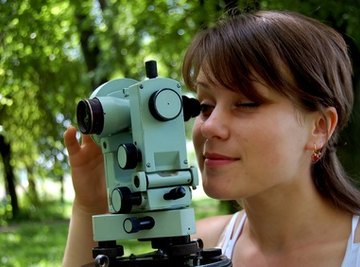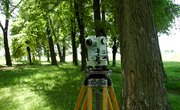
Theodolites are important surveying instruments that are utilized when measuring both vertical and horizontal angles. Theodolites are used in the construction industry and for mapping applications. These electronic devices are particularly useful in remote locations and have been adapted for use in meteorology and in rocket technology. Because theodolites can gauge location, they are also used for navigational purposes.
Basic Construction
A fundamental theodolite incorporates a small telescope that is connected to mechanisms that gauge both vertical and horizontal angles. The theodolite is secured to a base, which rotates on a tripod. The telescope itself is secured within horizontal and vertical axes. The telescope is adjusted to point at the object that is being sighted, and the angles are then checked on the two scales that are incorporated into the telescope. In the most recently available theodolites, the readings of both horizontal and vertical circles are performed by a rotary encoder. The most modern theodolites incorporate infrared measuring tools.
Vertical Scale
This scale, which is also referred to as a vertical circle, incorporates a 360-degree scale. The vertical scale is secured with its center in a co-linear position to the trunnion axis. This scale is used to measure the vertical angle, which exists between the horizontal and the collimation axis, or line of sight.
Vertical Clamp and Tangent Screw
The vertical clamp, which is positioned on a standard, holds the telescope at a specific angle. Once released, this clamp permits free transition of the telescope. With the vertical clamp in place, the vertical tangent screw allows for fine adjustments to be made.
Horizontal Scale
This scale, which is also termed the horizontal circle, incorporates a full 360-degree scale. The horizontal scale is typically positioned between the lower and upper plates. This scale or circle has been designed for complete independent rotation. The horizontal scale is utilized to delineate the horizontal direction in which the telescope will be pointed, relative to a fixed direction.
The Lower Horizontal Clamp and Tangent Screw
This clamp fixes the horizontal circle to the lower plate. The circle is able to rotate about the vertical axis, once the clamp is loosened. Even when clamped, it is possible to rotate the horizontal circle, by making use of the lower-horizontal tangent screw.
Circle Reading and Optical Micrometer
In modern theodolites, both circles are typically read through a single eyepiece. This eyepiece is usually positioned on one of the standards. Mirrors, which are incorporated into the instrument, reflect light onto the vertical and horizontal circles to facilitate reading.
References
About the Author
Virtually growing up in a computer repair shop, Naomi Bolton has held a passion for as long as she can remember. After earning a diploma through a four year course in graphic design from Cibap College, Bolton launched her own photography business. Her work has been featured on Blinklist, Gameramble and many others.
Photo Credits
theodolite survey serie portret image by Kostyantyn Ivanyshen from Fotolia.com
